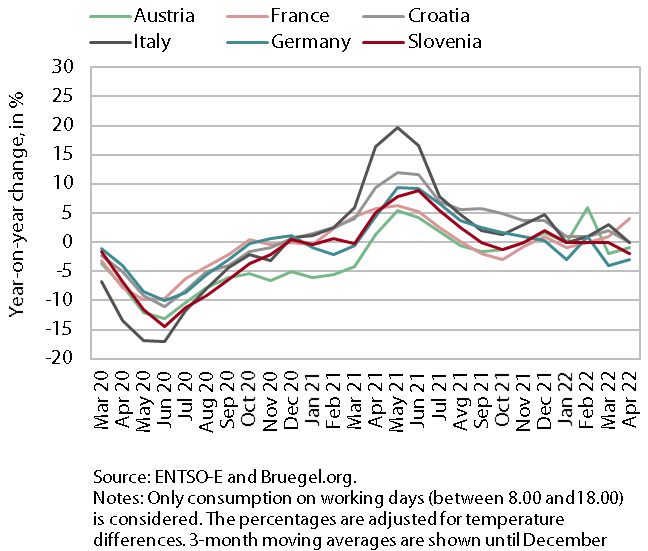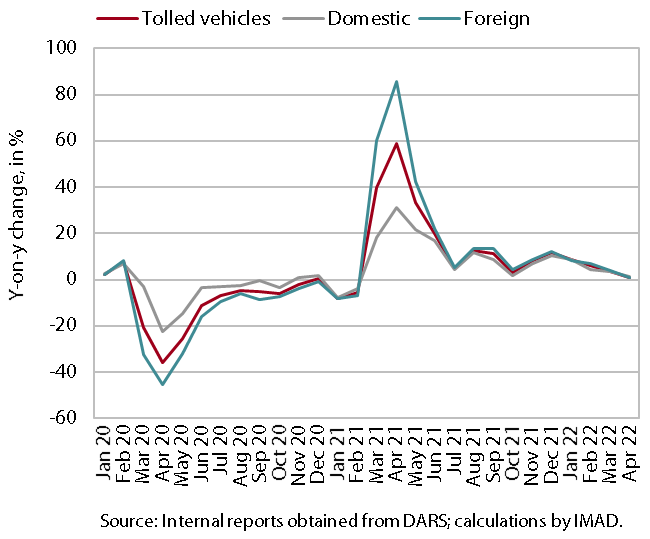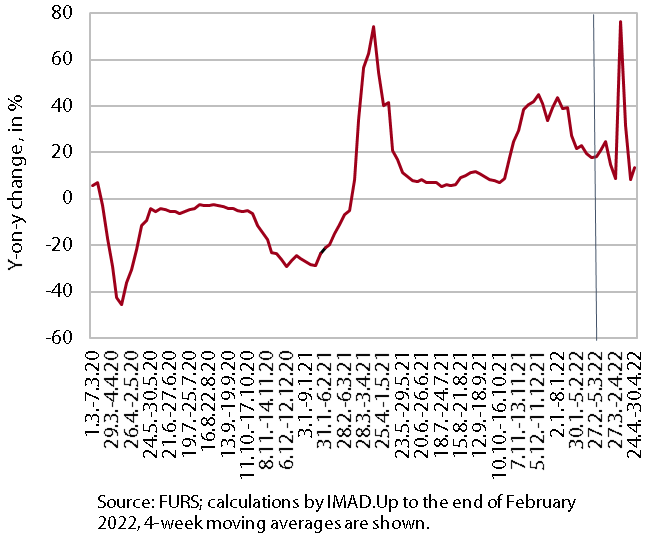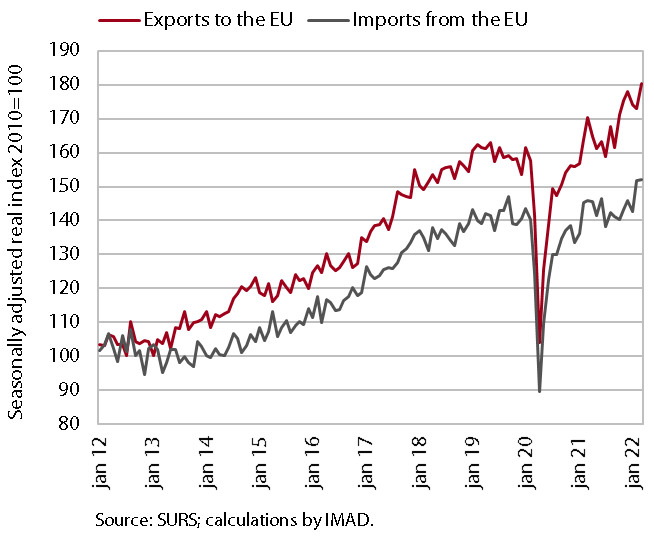Charts of the Week
Current economic trends from 3 to 6 May 2022: registered unemployment, electricity consumption, traffic of electronically tolled vehicles and other charts
As for the labour market, unemployment continues to fall and demand for labour remains high. The number of unemployed in April was more than a quarter lower than in the same period last year and the lowest on record. Similar to Slovenia’s main trading partners, electricity consumption in April was lower than in the same period last year and lower than in April 2019. Freight traffic on Slovenian motorways is still higher than a year ago and significantly higher than before the epidemic. According to data on fiscal verification of invoices, turnover in the second half of April was higher in nominal terms than a year ago in most sectors (except in the sale of motor vehicles). According to preliminary data, trade in goods increased slightly in current terms in the first quarter and year-on-year growth remained strong. Given the ongoing supply chain disruptions and the development of the war in Ukraine, the less favourable export expectations have not yet been significantly reflected in foreign trade data.
Registered unemployment, April 2022

Against the backdrop of the lowest unemployment rate to date, the decline in the number of registered unemployed in April was similar to the previous month (-2.1%), according to the seasonally adjusted data. According to original data, 58,081 people were unemployed at the end of April, 4.1% fewer than at the end of March and 26.7% fewer than a year earlier. Under conditions of high demand for labour, which is also reflected in the high vacancy rate, the number of long-term unemployed has also been declining since May last year – in April, their number was 23.6% lower than in April 2021. Of the long-term unemployed, more than two-thirds have been unemployed for more than two years.
Electricity consumption, April 2022

Electricity consumption in April was 2% lower than a year ago and 8% lower than in April 2019. The decrease in consumption is a consequence of lower industrial electricity consumption related to supply chain problems and material shortages, which for some sectors (e.g. the automotive industry) were exacerbated with the outbreak of the war in Ukraine. The lower consumption compared to April 2019 could also be the result of a somewhat less favourable timing of this year’s May Day holidays from the perspective of the functioning of the economy. Among Slovenia’s main trading partners, consumption in April was higher year-on-year in France (4%), roughly the same in Italy and Croatia, and lower in Austria and Germany (-1% and -3%, respectively). Compared to April 2019, consumption was lower in France (-6%), Germany (-5%), Austria (-4%) and Italy (-2%), while it was higher in Croatia (3%).
Traffic of electronically tolled vehicles on Slovenian motorways, April 2022

In April, freight traffic on Slovenian motorways was 1% higher year-on-year. Current trends are no longer closely linked to the impact of the epidemic and growth was lower year-on-year, mainly due to one less working day. Compared to the same period of 2019, freight traffic volumes were 14% higher in April (adjusted for working days). The share of foreign vehicle traffic, which varies slightly from month to month, was 59% in April, in line with the usual average for that month, whereas in the first year of the epidemic it was significantly lower in April, at 51%. Due to several public holidays, April is one of the months with average traffic volumes, and this April traffic volumes were also significantly lower than in March (by more than a tenth).
Turnover based on fiscal verification of invoices, in nominal terms, 17–30 April 2022

According to data on the fiscal verification of invoices, total turnover between 17 and 30 April 2022 was 11% higher year-on-year in nominal terms and 9% higher than in the same period of 2019. The year-on-year growth was much lower than in the previous two weeks, mainly due to the reopening of shops and certain services (after a lockdown between 1 and 11 April) and the lifting of restrictions on movement between regions last year. Growth fell sharply in retail and wholesale trade, while turnover in the sale of motor vehicles was lower than a year ago. As accommodation and food service activities and certain entertainment services gradually resumed last year, the year-on-year turnover growth in these services also declined significantly, although it was still very high.
Trade in goods, March 2022

Trade in goods increased in current terms in the first quarter of this year. Compared to the previous quarter, real exports of goods increased, as did real exports to EU Member States (seasonally adjusted). The increase was mainly the result of growth in March, as exports had fallen in current terms in the first two months. Quarter-on-quarter, real imports of goods, especially from EU Member States, grew even more strongly than exports (seasonally adjusted). Year-on-year growth in trade with EU Member States remained very high in the first quarter, exceeding pre-epidemic levels since the beginning of last year. Due to the war in Ukraine, export expectations declined sharply in March and April but were still higher than before the epidemic.
